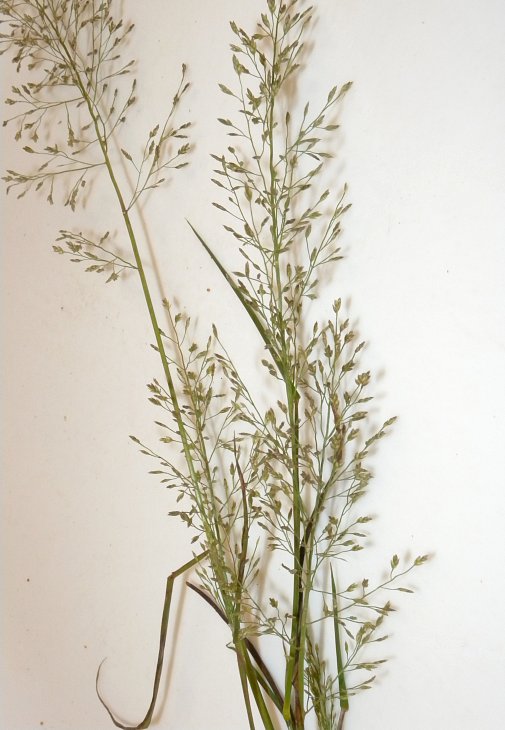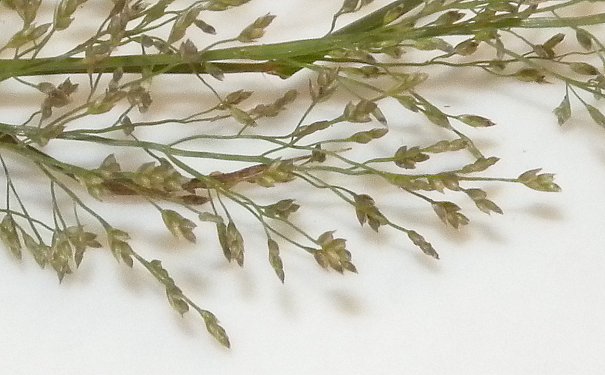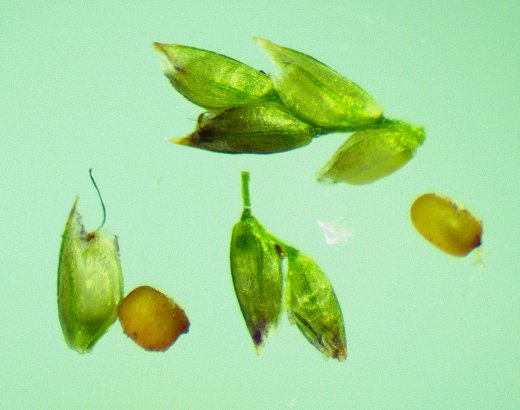Sandbar Love Grass
Eragrostis frankii frankii
Grass family (Poaceae)
Eragrostis frankii frankii
Grass family (Poaceae)
Description:
This grass is a summer annual about 5–12" (12.5–30 cm.) tall, often
forming tufts of
leafy culms. The culms often have somewhat decumbent bases, otherwise
they are ascending to erect. Individual culms are light green, terete
and hairless, sometimes becoming purplish or brown at their base. Two
or more alternate leaves occur along
each culm below the inflorescence. The ascending leaf blades are 1–4"
(2.5–10 cm.) long
and 1–4 mm. across; they are grayish green to medium green,
dull-colored, either flat or with slightly upturned margins, and
hairless (or nearly so). There are no glandular pits along the leaf
margins. The leaf sheaths are light to medium green (or grayish
green), vertically veined, and hairless (or nearly so). The
ligules are very short (less than 1 mm. long) and they have white hairs
up to 2.5 mm. long; the latter appear as tufts at the apex of the leaf
sheaths. The nodes are swollen, hairless, and light green above;
they become more narrow and form a dark ring below. Each fertile culm
terminates in a
somewhat airy panicle of spikelets about 2–5½" long and about one-half
to two-thirds as much across; the panicle is ellipsoid to ovoid in
outline.

The panicle has a central rachis (stalk) along which there are either alternate or whorls of 2–3 ascending lateral branches. The lateral branches subdivide into divergent secondary branches and/or divergent pedicels, the latter terminating in solitary floral spikelets. The rachis, branches, and pedicels are slender and sometimes slightly wiry; they are dull light green and hairless (or nearly so). There are no tufts of white hair at the axils of the rachis and lateral branches. The pedicels are short (2–6 mm. long). Individual spikelets are 2–3 mm. long and 1.5–2 mm. across; they have 2 glumes at the bottom and 3–5 lemmas above. The glumes and lemmas are loosely stacked together into 2 columnar ranks with jagged sides. The smaller glume is about 1 mm. long, lanceolate in shape, single-veined, and convex to somewhat keeled along the outer side; the larger glume is similar, except it is about 1.5 mm. long. The lemmas are about 1.5 mm. long (becoming a little shorter above), ovate-lanceolate in shape, 3-veined, and keeled along their outer sides; they lack glandular pits along their keels. Both the glumes and lemmas are light green or light grayish green, sometimes becoming slightly purple toward their tips; they are hairless. The florets of the lemmas are perfect; they have tiny purple anthers. The blooming period occurs during late summer or early autumn, lasting about 1 month. However, individual florets remain in bloom for only 1 week; they are cross-pollinated by the wind.

Afterwards, each fertile floret is replaced by a single grain about 0.5 mm. long. These tiny grains are tan to reddish brown, short-oblongoid to oblongoid-ovoid in shape, slightly flattened (compressed), and hairless. Sometimes the grains may have a shallow groove along one side. The grains are small enough to be blown about by the wind or carried by water. The root system is a shallow crown of fibrous roots. This grass reproduces by reseeding itself.
Cultivation: The preference is full sun, moist to mesic conditions, and sandy soil. Most growth and development occurs during the summer.
Range & Habitat: Sandbar Love Grass (Eragrostis frankii frankii) occurs occasionally throughout Illinois, where it is native (see Distribution Map). This grass is widely distributed in the eastern one-half of the United States. Habitats include sandbars along rivers, sandy banks of rivers, sandy soil along roadsides and railroads, and waste ground. It has also been reported to occur in wet depressions of glades in Missouri. This grass is usually found in disturbed areas.

Faunal Associations: Insects that feed on the foliage and other parts of love grasses (Eragrostis spp.) include larvae of Neolasioptera agrostis and Cerodontha dorsalis (Grass Sheath Miner), larvae of Eurytomocharis eragrostidis (Love Grass Borer), both adults and larvae of Chaetocnema pulicaria (Corn Flea Beetle), Antoninoides parrotti (Felted Grass Mealybug) and Phenacoccus solenopsis (Solenopsis Mealybug), Colopha ulmicola (Elm Cockscomb Aphid), and larvae of Poanes zabulon (Zabulon Skipper); see Felt (1917), Needham et al. (1928), Clark et al. (2004), ScaleNet website (2014), Blackman & Eastop (2013), and Bouseman et al. (2006). The Deer Mouse eats the seeds of these grasses to a minor extent (Houtcooper, 1978). The seeds of Sandbar Love Grass (Eragrostis frankii frankii) and other love grasses are small enough to be transported on the muddy feet of mammals, shoes of humans, and the feathers of birds to new areas.
Photographic Location: Sandy soil along a river at Fox Ridge State Park in Coles County, Illinois.

Comments: This is one of several love grasses (Eragrostis spp.) in Illinois that can be difficult to distinguish from each other. Sandbar Love Grass (Eragrostis frankii frankii) differs from many similar species by the small number of lemmas (3–5) in its spikelets. These lemmas are loosely arranged, causing the sides of its spikelets to be somewhat jagged, rather than smooth. Compared to Lace Grass (Eragrostis capillaris), Sandbar Love Grass has smaller inflorescences with shorter pedicels (2–6 mm. long); it also lacks hairs along the margins of its sheaths. Another similar species, India Love Grass (Eragrostis pilosa), has more lemmas in its spikelets (5–17) and the branching structure of its panicles is less divergent. Similarly, Lesser Love Grass (Eragrostis minor) also has more lemmas in its spikelets (5-18) and its leaves have glandular pits along their margins (visible with a 10x hand lens or a microscope), while Sandbar Love Grass lacks such pits. A variety of Sandbar Love Grass that is rare in Illinois, Eragrostis frankii brevipes, differs from the typical variety by having longer spikelets (4–5 mm.) that have more lemmas (6–7). However, like the typical variety of Sandbar Love Grass, this latter variety has spikelets with jagged sides, while the spikelets of similar love grasses usually have smooth sides.

The panicle has a central rachis (stalk) along which there are either alternate or whorls of 2–3 ascending lateral branches. The lateral branches subdivide into divergent secondary branches and/or divergent pedicels, the latter terminating in solitary floral spikelets. The rachis, branches, and pedicels are slender and sometimes slightly wiry; they are dull light green and hairless (or nearly so). There are no tufts of white hair at the axils of the rachis and lateral branches. The pedicels are short (2–6 mm. long). Individual spikelets are 2–3 mm. long and 1.5–2 mm. across; they have 2 glumes at the bottom and 3–5 lemmas above. The glumes and lemmas are loosely stacked together into 2 columnar ranks with jagged sides. The smaller glume is about 1 mm. long, lanceolate in shape, single-veined, and convex to somewhat keeled along the outer side; the larger glume is similar, except it is about 1.5 mm. long. The lemmas are about 1.5 mm. long (becoming a little shorter above), ovate-lanceolate in shape, 3-veined, and keeled along their outer sides; they lack glandular pits along their keels. Both the glumes and lemmas are light green or light grayish green, sometimes becoming slightly purple toward their tips; they are hairless. The florets of the lemmas are perfect; they have tiny purple anthers. The blooming period occurs during late summer or early autumn, lasting about 1 month. However, individual florets remain in bloom for only 1 week; they are cross-pollinated by the wind.

Afterwards, each fertile floret is replaced by a single grain about 0.5 mm. long. These tiny grains are tan to reddish brown, short-oblongoid to oblongoid-ovoid in shape, slightly flattened (compressed), and hairless. Sometimes the grains may have a shallow groove along one side. The grains are small enough to be blown about by the wind or carried by water. The root system is a shallow crown of fibrous roots. This grass reproduces by reseeding itself.
Cultivation: The preference is full sun, moist to mesic conditions, and sandy soil. Most growth and development occurs during the summer.
Range & Habitat: Sandbar Love Grass (Eragrostis frankii frankii) occurs occasionally throughout Illinois, where it is native (see Distribution Map). This grass is widely distributed in the eastern one-half of the United States. Habitats include sandbars along rivers, sandy banks of rivers, sandy soil along roadsides and railroads, and waste ground. It has also been reported to occur in wet depressions of glades in Missouri. This grass is usually found in disturbed areas.

Faunal Associations: Insects that feed on the foliage and other parts of love grasses (Eragrostis spp.) include larvae of Neolasioptera agrostis and Cerodontha dorsalis (Grass Sheath Miner), larvae of Eurytomocharis eragrostidis (Love Grass Borer), both adults and larvae of Chaetocnema pulicaria (Corn Flea Beetle), Antoninoides parrotti (Felted Grass Mealybug) and Phenacoccus solenopsis (Solenopsis Mealybug), Colopha ulmicola (Elm Cockscomb Aphid), and larvae of Poanes zabulon (Zabulon Skipper); see Felt (1917), Needham et al. (1928), Clark et al. (2004), ScaleNet website (2014), Blackman & Eastop (2013), and Bouseman et al. (2006). The Deer Mouse eats the seeds of these grasses to a minor extent (Houtcooper, 1978). The seeds of Sandbar Love Grass (Eragrostis frankii frankii) and other love grasses are small enough to be transported on the muddy feet of mammals, shoes of humans, and the feathers of birds to new areas.
Photographic Location: Sandy soil along a river at Fox Ridge State Park in Coles County, Illinois.

Comments: This is one of several love grasses (Eragrostis spp.) in Illinois that can be difficult to distinguish from each other. Sandbar Love Grass (Eragrostis frankii frankii) differs from many similar species by the small number of lemmas (3–5) in its spikelets. These lemmas are loosely arranged, causing the sides of its spikelets to be somewhat jagged, rather than smooth. Compared to Lace Grass (Eragrostis capillaris), Sandbar Love Grass has smaller inflorescences with shorter pedicels (2–6 mm. long); it also lacks hairs along the margins of its sheaths. Another similar species, India Love Grass (Eragrostis pilosa), has more lemmas in its spikelets (5–17) and the branching structure of its panicles is less divergent. Similarly, Lesser Love Grass (Eragrostis minor) also has more lemmas in its spikelets (5-18) and its leaves have glandular pits along their margins (visible with a 10x hand lens or a microscope), while Sandbar Love Grass lacks such pits. A variety of Sandbar Love Grass that is rare in Illinois, Eragrostis frankii brevipes, differs from the typical variety by having longer spikelets (4–5 mm.) that have more lemmas (6–7). However, like the typical variety of Sandbar Love Grass, this latter variety has spikelets with jagged sides, while the spikelets of similar love grasses usually have smooth sides.